Tackling child poverty delivery plan: forecasting child poverty in Scotland
Child poverty projections for Scotland independently produced by Howard Reed at Landman Economics and Graham Start at Virtual Worlds Research.
Chapter 3. Results
3.1 Headline child poverty measures
Figure 3.1 shows the results for the proportion of children in poverty under each of the four featured measures, starting with 2015/16 (the most recent year for which published child poverty statistics were available at the time or writing) and ending in 2030/31. Note that these headline measures are based on scenario (c) (where all the planned UK Government and Scottish Government tax and social security reforms are implemented over the forecast period). Measure 1 (relative child poverty) is shown in blue, Measure 2 (absolute child poverty) in red, Measure 3 (combined material deprivation and below 70% of median AHC income) in grey, and Measure 4 (persistent poverty) in yellow.
Figure 3.1 shows that the relative child poverty rate (Measure 1) is forecast to rise sharply between 2015/16 and the current tax year, 2017/18 (from 26.5 per cent to just under 31 per cent). A further sharp increase is forecast between 2017/18 and 2020/21, to 34.5 per cent. After this, during the 2020s, relative child poverty is forecast to continue increasing, but at a slower rate, before levelling out at just under 38 per cent from 2027/28 onwards.
The absolute child poverty measure (Measure 2) begins to rise sharply after 2016/17, rising from just over 25 per cent in 2016/17 to just under 32 per cent in 2019/20. After this, absolute poverty rises more slowly before levelling off at just over 33 per cent in 2021/22, and then gradually falling over the rest of the 2020s before reaching 31.6 per cent in 2030/31 – around the same level it is forecast to be at in 2019/20.
Measure 3 (combined material deprivation and low income) is forecast to rise from just over 14 per cent in 2016/17 to 16 per cent in 2019/20, and then rises less quickly over the early 2020s before levelling off at around 16.5 per cent in 2023/24. It is then forecast to stay at around this level for the rest of the 2020s.
Measure 4 (persistent poverty) is projected to rise from just under 13 per cent in 2015/16 to 15.5 per cent in 2026/27 before levelling off at around this level for the rest of the forecast period.
A key driver of the sharp increase in all four measures of child poverty (but particularly measures 1 and 2) is the reduction in the real-terms generosity of the social security system between 2016/17 and 2020/21 as a result of planned reforms by the UK Government. This is explained and analysed in more detail in the next section, which looks at the differences between trends in child poverty under the three featured policy scenarios.
Figure 3.1. Headline child poverty rate forecasts, Scotland, scenario (c), 2015/16 to 2030/31
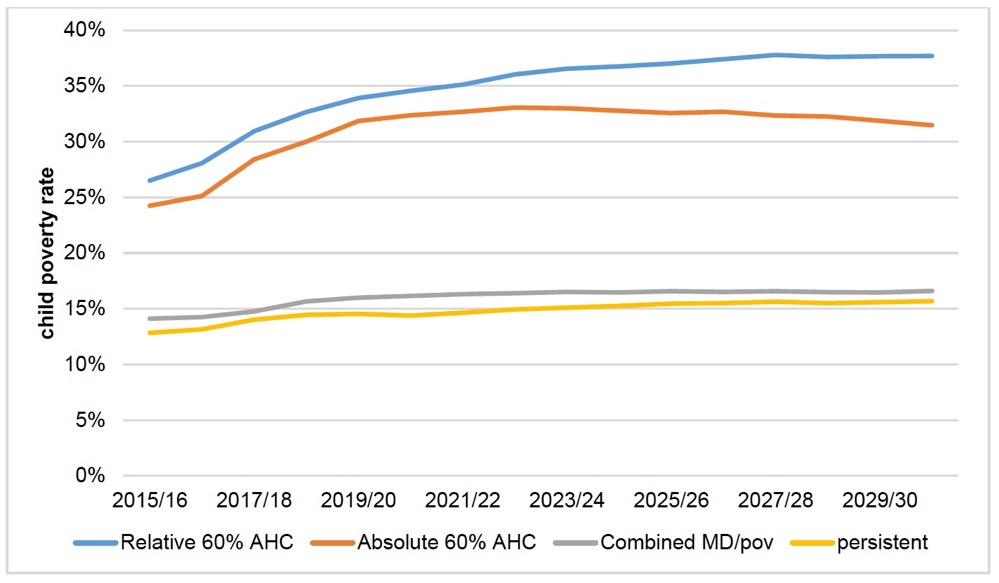
Source: calculations based on outputs from tax-transfer model using FRS pooled dataset 2012/13 to 2015/16
Figure 3.2 shows the same headline results as Figure 3.1 but expressed in terms of the forecast number of children in poverty rather than the forecast poverty rate. Because projections for the growth of population of children in Scotland show almost no increase over the forecast period as a whole (a projected population of 1.079 million in both 2015/16 and 2030/31, with a maximum population of 1.089 million in the mid-2020s), the pattern of increases in child poverty looks almost identical in Figure 3.2 compared to Figure 3.1. For this reason, all subsequent graphs in this report use child poverty rates rather than absolute numbers in poverty.
Figure 3.2. Headline forecast numbers of children in poverty, Scotland, scenario (c), 2015/16 to 2030/31
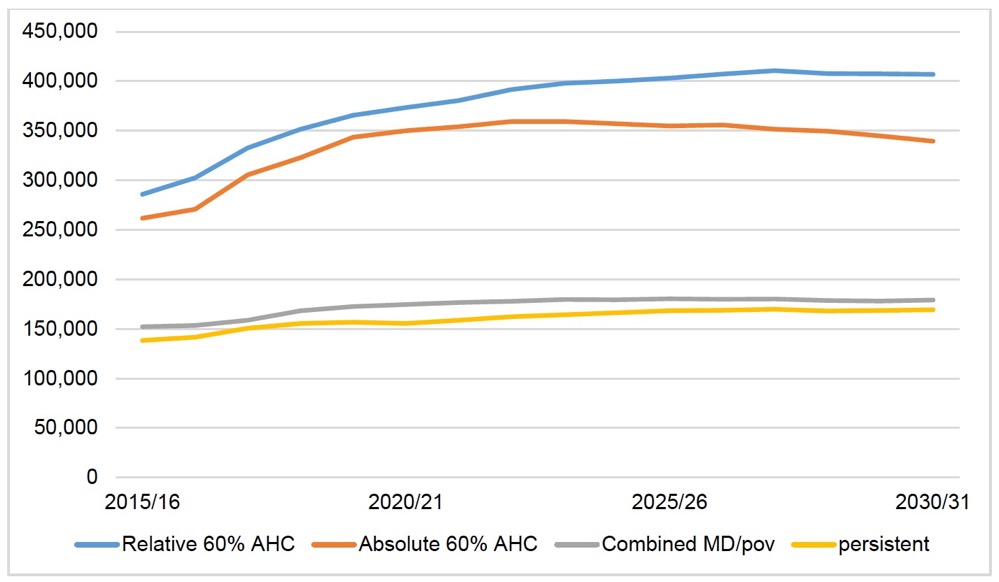
Source: calculations based on outputs from tax-transfer model using FRS pooled dataset 2012/13 to 2015/16
3.2 The impact of UK and Scottish Government policies on child poverty: scenario comparisons
Analysing the difference between forecast child poverty rates under the scenarios (a), (b) and (c) outlined in Section 2.6 is useful for providing more information about what the drivers of the forecast increase in poverty are. Figure 3.3 shows a comparison of the forecasts for child poverty measure 1 (relative poverty) under the three scenarios;
a) The 2017-18 system with no further reforms, uprated for inflation;
b) Scenario (a) plus subsequent announced UK Government tax and social security reforms;
c) Scenario (b) plus subsequent announced Scottish Government tax and social security reforms.
Figure 3.3 shows that the announced UK government reforms after 2017-18 (the orange line) result in a substantial further increase in relative child poverty compared to scenario (a) where the subsequent UK reforms are not implemented (the blue dashed line). This reflects the impact of the freeze on the uprating of working age social security benefits, in particular. One of the reasons that relative poverty starts to increase at a faster rate after 2016/17 is the impact of the social security uprating freeze, combined with relatively high inflation in the wake of the EU referendum vote in June 2016 (for example CPI was running at 2.7% in January 2018, compared to a Bank of England target of 2 per cent) ( ONS 2018). Other policies, such as the introduction of the two-child limit for Housing Benefit, tax credits and Universal Credit in April 2017, are also contributing factors to the measured increase in Scenario (b). When UK Government-mandated reforms for 2018/19 and subsequent years are stripped out, relative poverty still increases, but does so at a much slower rate; by 2020/21, relative poverty is forecast to be just under 32 per cent in scenario (a), compared to 34.5 per cent in scenario (b).
The role of the Scottish tax and social security reforms in explaining trends in forecast child poverty
Comparing scenario (b) with scenario (c), we see that the Scottish Government’s planned tax and social security reforms have a very limited impact on relative child poverty. Across the whole forecast period, the divergence between forecast child poverty in scenario (b) and scenario (c) is always within the statistical margin of error for the forecast. In other words, there is no statistically significant impact of the Scottish Government’s reforms. This section analyses why the forecast impacts of the reforms are so small.
In the case of the increase in Carers’ Allowance, the smallness of the effect is because the measure does not affect enough households with children to cause any measurable impact on child poverty [19] . And while the Best Start Grant is received by a far higher proportion of families with children – and low-income families with children, in particular – than Carers’ Allowance, the additional payments from the grant – expressed in weekly terms – are not large enough to make an appreciable difference to the poverty rate.
The changes to income tax from 2018/19 onwards affect a much larger proportion of the Scottish population than either the increase in Carers’ Allowance or the introduction of the Best Start Grant. However, the maximum gain from the reduction in the rate of income tax to 19% on the first £2,000 of taxable income is £20 per year, or just under 40 pence per week. Even in a household with two earners in the relevant gross income bracket, this is not a large enough sum by itself to result in a statistically significant reduction in child poverty. Meanwhile, the increase of 1% in marginal income tax rates above £24,000 per year gross income results in additional tax payments for people earning above £26,000 per year, but in most cases households with one or more earners in this income bracket are above the relative (and absolute) poverty lines and so the increase in tax does not have any impact on poverty.
Appendix 3 presents results from an analysis of the number of children in households in the 4-year pooled Scottish FRS sample who move out of, or into, relative AHC poverty as a result of the Scottish reforms. The results show that the number of children moving into or out of poverty is extremely small in any given part of the forecast period.
Figure 3.3. Policy scenario comparison: Child poverty measure 1 (Relative 60% AHC)
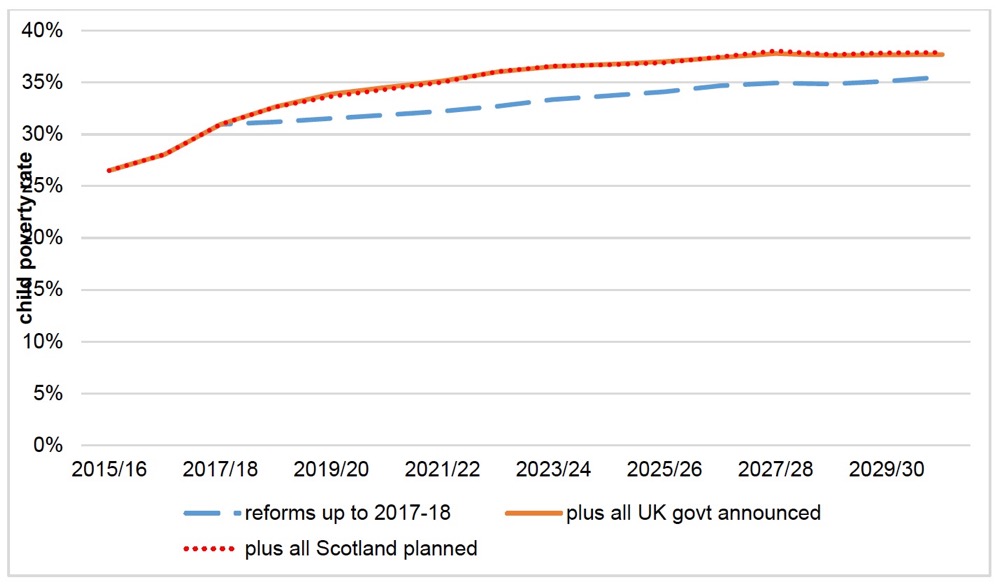
Source: calculations based on outputs from tax-transfer model using FRS pooled dataset 2012/13 to 2015/16
Figure 3.4 shows the comparison of policy scenarios for child poverty measure 2 (absolute poverty). Once again, comparing scenarios (a) and (b) shows major differences in the forecast path for child poverty in Scotland. In scenario (a), where the effects of future planned UK Government reforms are not included, absolute child poverty rises fairly slowly, to just over 30 per cent by 2022/23, then begins to fall from 2026/27 onwards. By contrast, in scenario (b) there is a much faster increase in absolute poverty after 2017/18, to 33 per cent by 2022/23. As with the relative poverty measure, the additional impact of the Scottish Government’s planned reforms on absolute child poverty in scenario (c) compared to (b) is very minor; they result in no statistically significant change in child poverty rates over the forecast period.
Figure 3.4. Policy scenario comparison: Child poverty measure 2 (Absolute 60% AHC)
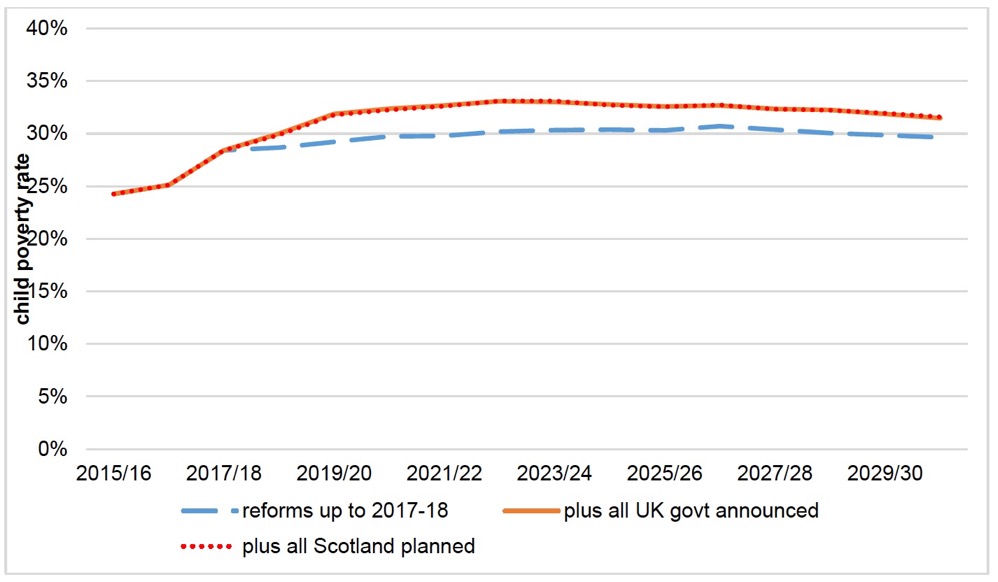
Source: calculations based on outputs from tax-transfer model using FRS pooled dataset 2012/13 to 2015/16
Figure 3.5 shows the policy scenario comparison for measure 3 (combined material deprivation and low income). The inclusion of UK Government planned reforms relative to a scenario of no further reforms after 2017-18 (scenario (b) compared to scenario (a)) shows a smaller percentage difference for measure 3 than either measure 1 or 2, but this is not surprising given that measure 3 starts from a lower percentage of children in poverty in 2015/16 (around 14 per cent compared to 24 per cent for measure 2 and 26 per cent for measure 1). A scenario of ‘no further reforms’ here leads to a gradual increase in the combined material deprivation and low income rate, from just under 15 per cent in 2017/18 to just over 15.5 percent by 2025/26. By comparison, when planned UK Government reforms are included, the poverty rate under measure 3 is around 1 percentage point higher. Including the Scottish Government’s planned tax and social security reforms makes almost no difference to measured child poverty under this measure [20] .
Figure 3.5. Policy scenario comparison: Child poverty measure 3 (Combined material deprivation and low income)
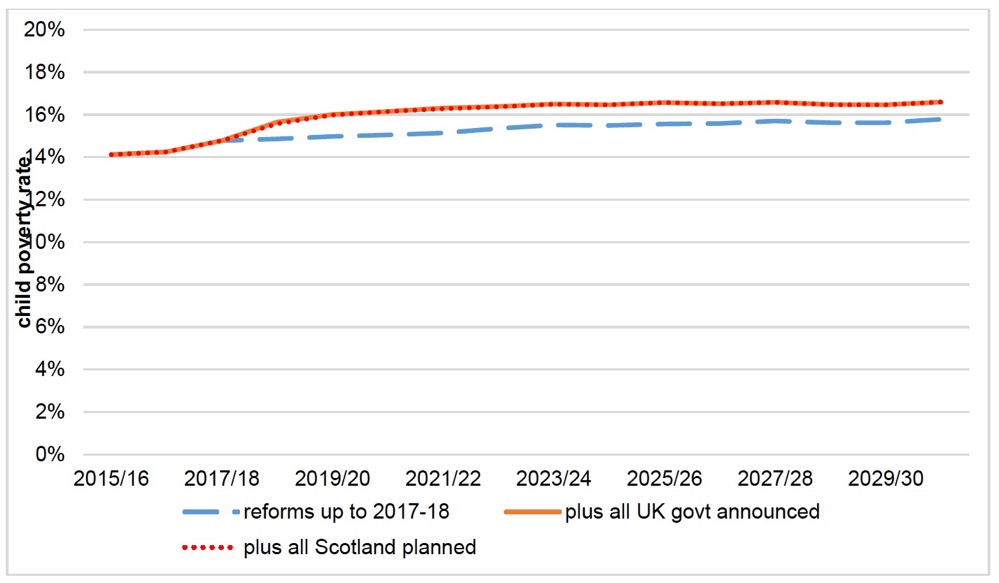
Source: calculations based on outputs from tax-transfer model using FRS pooled dataset 2012/13 to 2015/16
Finally in this section, Figure 3.6 shows the comparison of policy scenarios under measure 4 (the persistent poverty measure). Interestingly the planned UK Government reforms make slightly less difference to the child poverty rate using measure 4 than they do using measure 3, at least in the early years of the forecast. The forecast persistent poverty rate rises from 14 per cent in 2017/18 to 15 per cent by 2029/30 in scenario (a), compared to just over 15.5 per cent in scenario (b). This may be because low income in any given year of the FRS is less strongly related to the probability of being in persistent poverty (based on the regression coefficients from the Understanding Society data) than it is to the probability of being in material deprivation (based on the coefficients from the FRS regression on the determinants of material deprivation). Comparison of the results for scenario (b) and (c) show that the Scotland-specific reforms to tax and social security have essentially no impact on forecast poverty rates under this measure.
Figure 3.6. Policy scenario comparison: Child poverty measure 4 (persistent poverty)
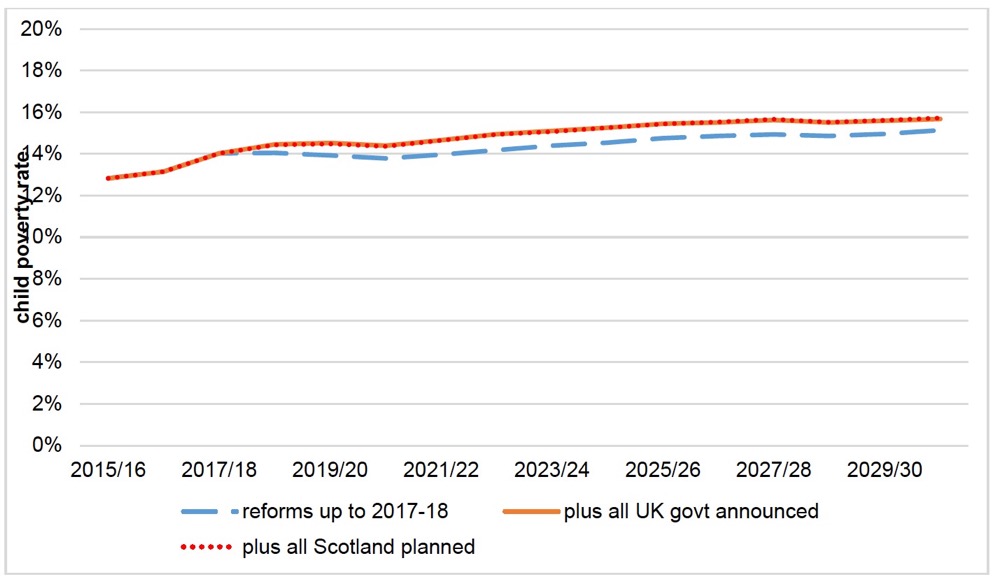
Source: calculations based on outputs from tax-transfer model using FRS pooled dataset 2012/13 to 2015/16 and regression modelling using Understanding Society data Waves 3 to 6
3.3 Confidence intervals for measures 3 and 4
As explained in Section 2.3 above, the estimates for poverty measures 3 and 4 are subject to greater uncertainty than measures 1 and 2 because material deprivation and persistent poverty cannot be calculated directly using the output from the tax-transfer microsimulation model but have to be estimated using regression predictions based on the net income estimates from the model combined with coefficients from an FRS regression of the likelihood of material deprivation based on observable characteristics (for measure 3) and a USoc regression of the likelihood of persistent poverty based on observable characteristics (for measure 4). Each set of regression predictions uses a set of randomly drawn error terms for the FRS data when predicting the likelihood of each FRS household being in material deprivation or persistent poverty. By using a large number of random draws and recalculating poverty measures 3 and 4 for each draw it is possible to build up a distribution of estimated poverty rates for each year.
Figure 3.7 shows the upper and lower 95% confidence intervals [21] for poverty measure 3 based on this repeated random draw process (sometimes known as “Monte Carlo simulation”). Roughly speaking, the upper and lower confidence intervals are around 1 percentage point above and below the central estimate, respectively. Thus, measure 3 is relatively tightly estimated, despite the inherent uncertainty in forecasting material deprivation given that it cannot be modelled directly using standard microsimulation techniques. The forecast increase in the central estimate of combined poverty and material deprivation from around 13.5 per cent in 2015/16 to around 15.5 percent by 2024/25 is statistically significant [22] even taking into account the uncertainties introduced by the estimation procedure.
Figure 3.7. Confidence intervals, estimates of poverty measure 3 (combined material deprivation and relative poverty)
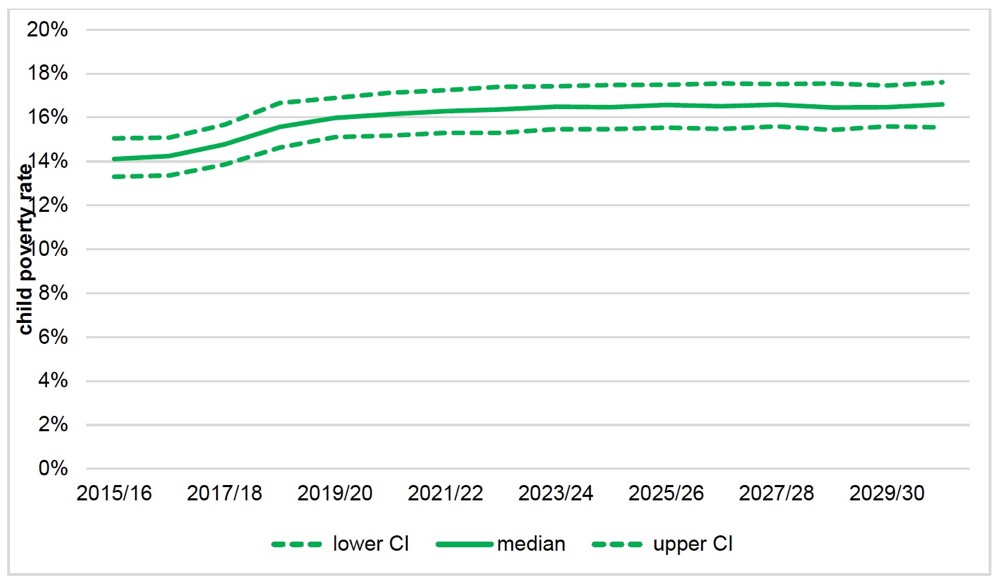
Source: Monte Carlo simulations based on outputs from tax-transfer model using FRS pooled dataset 2012/13 to 2015/16
Figure 3.8 shows upper and lower confidence intervals for poverty measure 4 in the same way. The confidence intervals are slightly wider than for measure 3 on average, perhaps reflecting the additional uncertainty introduced by using two datasets – Understanding Society and the FRS – for the estimate of persistent poverty. However, the increase in measure 4 is still statistically significant even after taking uncertainties based on the regression prediction into account.
Figure 3.8. Confidence intervals, estimates of poverty measure 4 (persistent poverty)
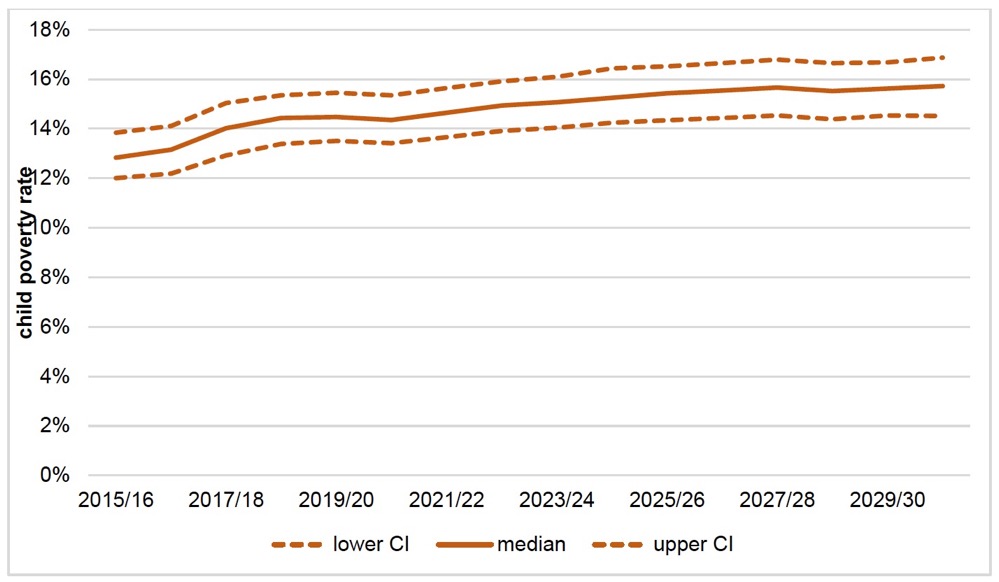
Source: calculations based on outputs from tax-transfer model using FRS pooled dataset 2012/13 to 2015/16 and regression results from Understanding Society Waves 3 to 6
3.4 Child poverty by family composition, number of children and employment status
This section breaks the results for the whole population of Scottish households with children (shown in Section 3.1 above) down into different household types to show trends for lone parent families compared to couples with children, households with different numbers of children, and the number of adults in work in the family (and whether they are in part-time or full-time work).
Lone parents and couples with children
Figure 3.9 shows trends in the four child poverty measures for children in lone parent families, while Figure 3.10 shows the equivalent trends for children in two-parent families. The two Figures are drawn on the same scale to allow an easy comparison of the results. Figure 3.9 shows very substantial projected increases for lone parents in relative poverty (measure 1) and absolute poverty (measure 2) between 2016/17 and 2021/22. In just one year – 2016/17 to 2017/18 – relative child poverty for lone parents jumps by over 8 percentage points (from just over 39 per cent to just under 48 per cent). Reaching just over 56 per cent by 2022/23, it is then forecast to carry on rising through most of the 2020s before levelling off at around 60 per cent in 202/28. Over the total forecast period relative poverty for lone parents grows by around 23 percentage points, while absolute poverty grows by around 17 percentage points. Absolute poverty for lone parents peaks just above 52 per cent in 2026/27, falling slightly after that. Combined material deprivation and low income poverty and persistent poverty show smaller (but still substantial rises) over the forecast period – the former goes from just over 28 per cent in 2015/16 to around 33.5 per cent by 2023/24, while the latter increases from 17.5 per cent in 2015/16 to around 23.5 per cent by 2030/31.
For children in couple families, the increases in relative and absolute poverty are not as large as for children in lone parent families, although still substantial. Relative poverty increases by just 6 percentage points between 2015/16 and 2023/24, peaking at 29.3 per cent in 2027/28. Absolute poverty increases by just over 5 percentage points to 26 per cent by 2022/23 before falling back under 24 per cent by the end of the forecast period. Interestingly, the increase in poverty under both these measures is smoother for children in couple families, whereas the trends for children in lone parents show a much sharper increase between 2016/17 and 2019/20 – driven by the cuts to social security benefits and tax credits, and the introduction of Universal Credit, over this period.
Trends in measure 3 (combined material deprivation and low income) and measure 4 (persistent poverty) show less of an increase for children in couple families than for lone parents. In fact, for measure 3 there is only a slight increase – by half of one percentage point between 2016/17 and 2021/22 – and by 2030/31 poverty on this measure is forecast to return to its level at the start of the forecast period. Persistent poverty is projected to increase by just over one percentage point, reaching 12 percent by 2027/28.
Figure 3.9. Child poverty rate forecasts: lone parent families
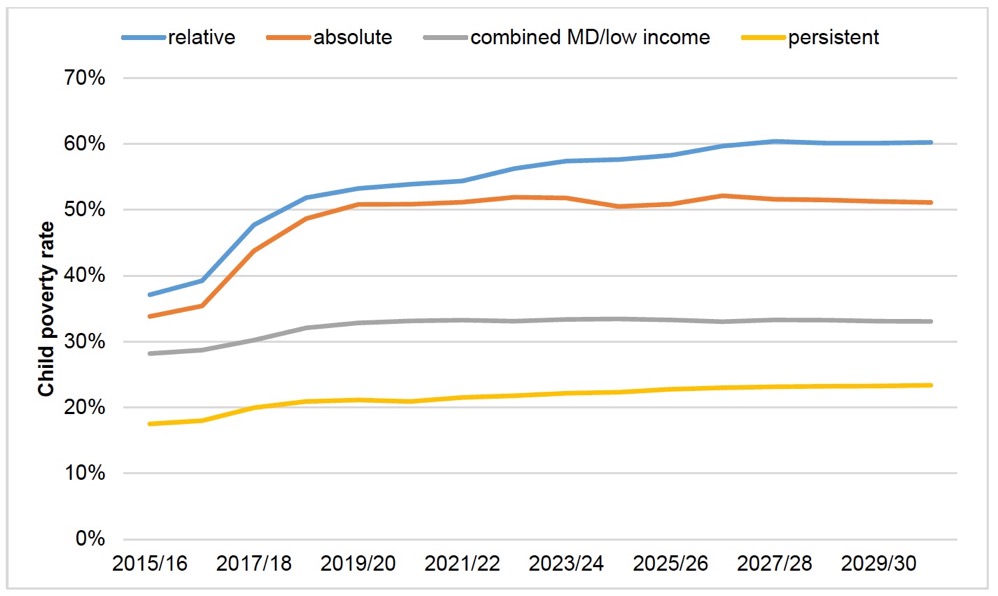
Source: calculations based on outputs from tax-transfer model using FRS pooled dataset 2012/13 to 2015/16
Figure 3.10. Child poverty rate forecasts: couples with children
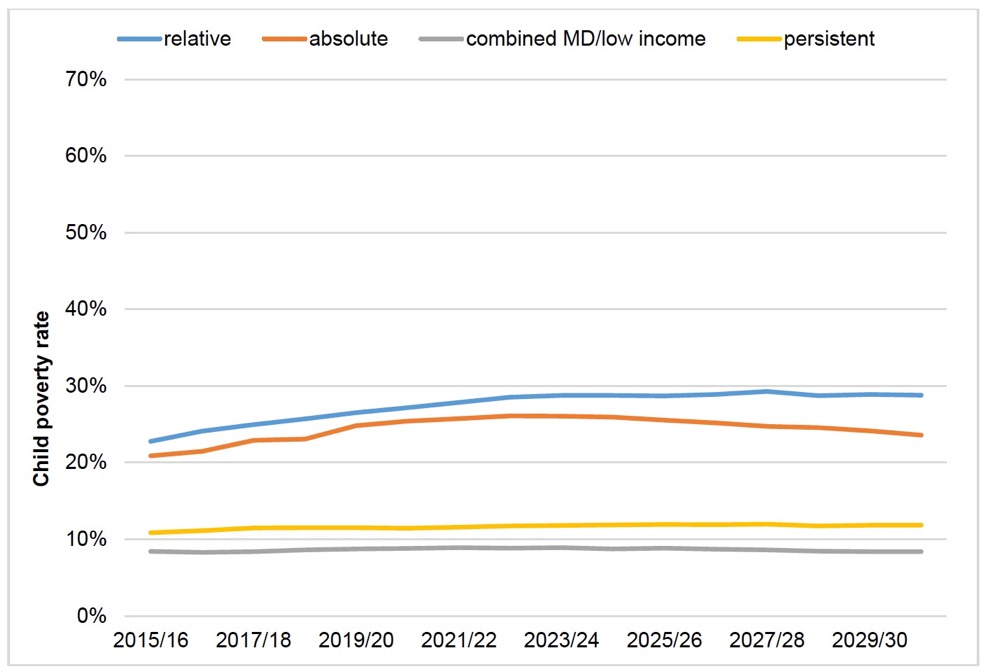
Source: calculations based on outputs from tax-transfer model using FRS pooled dataset 2012/13 to 2015/16
Number of children in household
Figures 3.11, 3.12 and 3.13 show trends in child poverty rates for children in families with one child, two children and three children respectively. The results for children in families with one child and two children show a reasonably similar pattern. Relative poverty increases from around 25 per cent to just under 31 per cent for children in families with one child, and from just over 22 per cent to 29 per cent for children in families with two children, over the forecast period. Meanwhile, absolute poverty rises by 3.5 percentage points before peaking at just under 27 per cent in 2020/21 for children in families with one child, and rises by just under 5 percentage points before peaking at 25 per cent in 2019/20 for children in families with two children. Absolute poverty falls by just over 2 percentage points over the 2020s for both groups. Meanwhile, combined poverty and material deprivation, and persistent poverty, both increase slightly for both groups over the forecast period.
The pattern for children in families with three or more children looks very different, with much more striking increases in poverty on all four measures. Relative poverty is forecast to increase very quickly from 33 per cent in 2015/16 to over 50 percent by 2022/23, with a further increase to 53 percent by 2027/28. Absolute poverty is forecast to increase from around 30 percent in 2015/16 to peak at over 47 percent in 2023/24, falling back only slightly to 46 percent by 2030/31. Combined material deprivation and low income is forecast to rise from around 22.5 percent in 2016/17 to 26 per cent by 2022/23, while persistent poverty is forecast to rise from just under 20 per cent at the start of the forecast period to 28 per cent by 2027/18.
The main reason why child poverty is forecast to rise so much more for children in families with three or more children is because of the social security reforms coming into force from 2016/17 onwards. The restriction of financial assistance in Housing Benefit, tax credits and Universal Credit to the first two children only for new claims – and many existing claims – from 2017 onwards, leads to a substantial fall in net income for families with three or more children, as shown by Reed and Portes (2018). The four-year freeze on uprating for most family social security benefits also has a very substantial impact on larger families who claim larger amounts of means-tested benefits, tax credits and Universal Credit (where rolled out) than families with one or two children on average.
Figure 3.11. Child poverty rate forecasts: families with one child
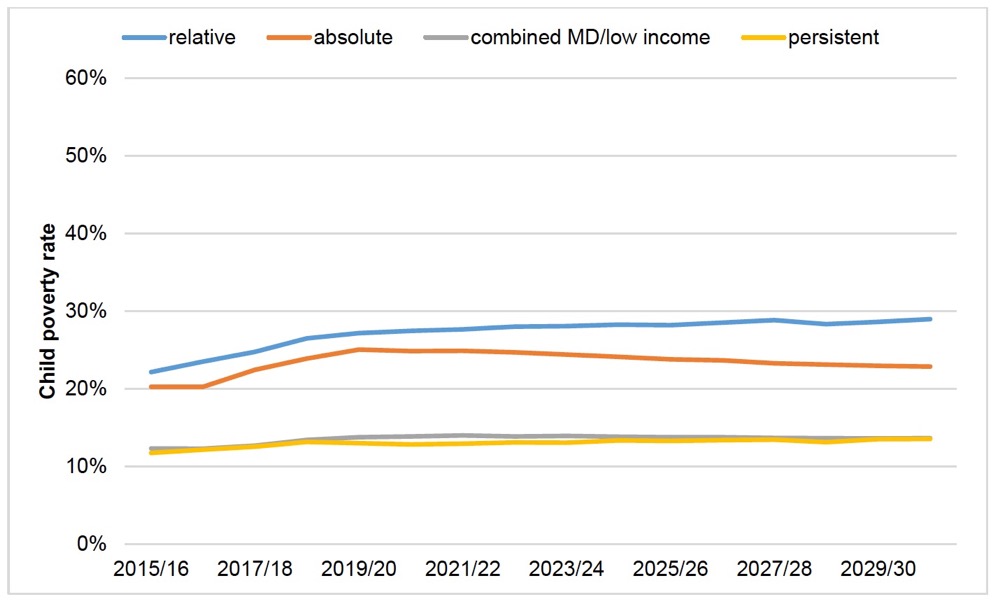
Source: calculations based on outputs from tax-transfer model using FRS pooled dataset 2012/13 to 2015/16
Figure 3.12. Child poverty rate forecasts: families with two children
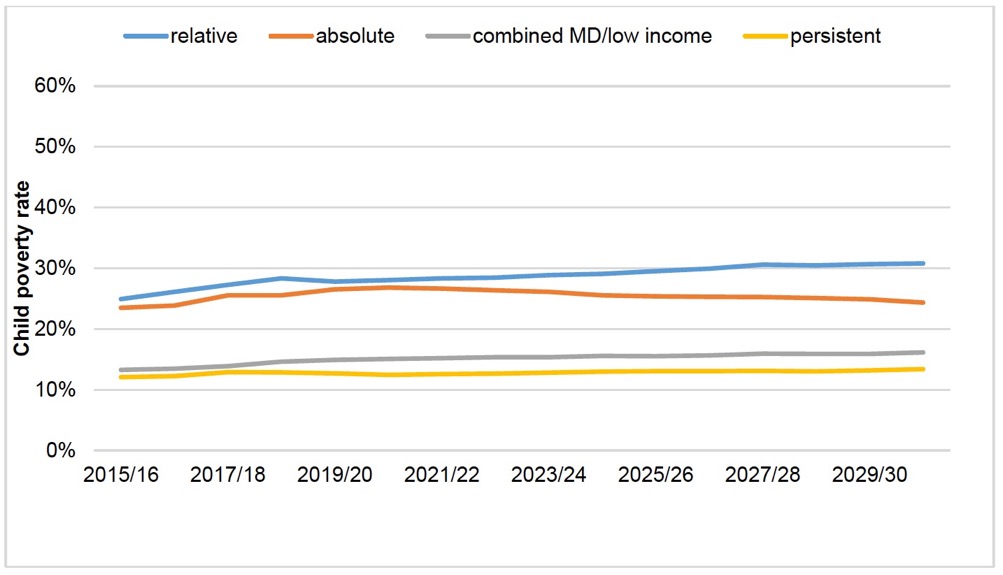
Source: calculations based on outputs from tax-transfer model using FRS pooled dataset 2012/13 to 2015/16
Figure 3.13. Child poverty rate forecasts: families with three or more children
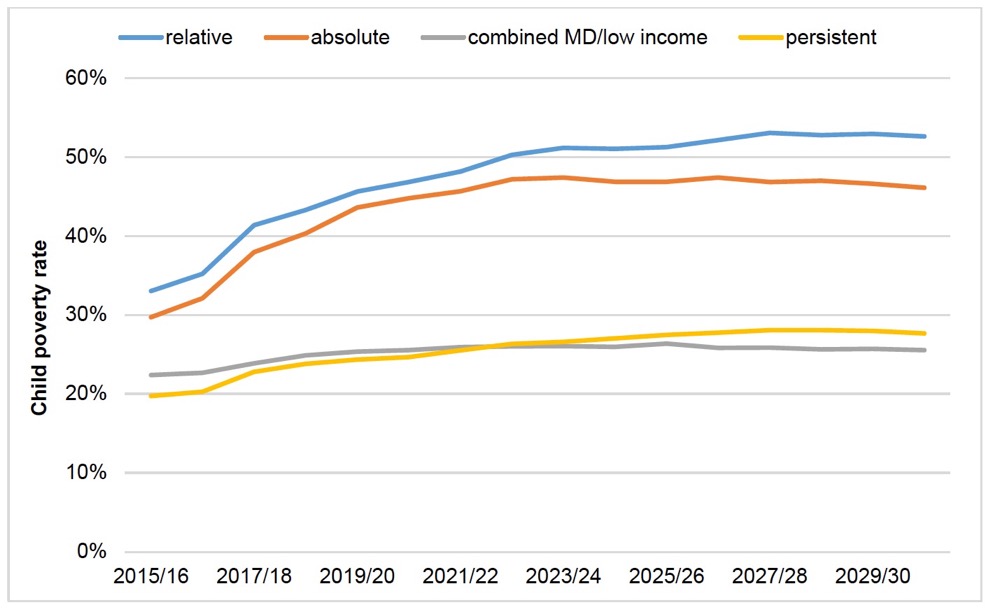
Source: calculations based on outputs from tax-transfer model using FRS pooled dataset 2012/13 to 2015/16
Employment Status
Figure 3.14 shows child poverty rate forecasts (for measure 1, the relative AHC poverty rate, only) for families disaggregated by the employment status of the adult(s) in the family. There is a substantial variation both in the measured poverty rates for children in families with different employment status and in the forecast growth of poverty in the years up to 2030/31.
Starting at the top of the Figure, the poverty rate for children in families where no adult is in paid work is already high (at 56 per cent) in 2015/16. Between 2016/17 and 2018/19 in particular, there is a very substantial increase in child poverty for children in this group, up to over 79 per cent by 2018/19 – an increase of 23 percentage points in two years. This is driven by the substantial cuts to social security benefits and tax credits and the introduction of Universal Credit which is rolled out by 2018/19 under our default assumptions. After 2018/19, child poverty for children in households where no adult is in paid work continues to increase (albeit more slowly), reaching over 91 per cent by 2027/28. This is a striking result – by the late 2020s, over nine in every ten children in families where no adult is in paid work is forecast to be in relative poverty, compared with just over half in 2015/16.
The blue line shows trends in child poverty for children in families where there is no adult in full-time paid work , but one or two adults in part-time paid work. Many of these families are lone parent families with the lone parent in part-time paid work. In 2015/16 the relative child poverty rate for children in this group is just over 39 per cent. The rate rises to 46 per cent by 2017/18 and then more slowly over the rest of the forecast period, reaching 57 per cent by 2028/29.
The yellow line shows child poverty for children in couple families where one partner is working full time and the other partner is not in paid work. Child poverty for children in this group initially rises from just over 29 per cent in 2015/16 to 36 per cent in 2017/18 before falling back to 31 per cent in 2018/19 (a fall which seems to be related to the roll-out of Universal Credit, which is relatively generous for low-income single earner families [23] ). However, poverty then rises relatively steeply for children in this group from 2019/20 onwards, reaching 48 per cent by 2030/31.
The green line shows relative poverty for children in families where one or more of the adults is full-time self-employed. Poverty for this group is just over 28 per cent in 2017/18, with a substantial jump in forecast child poverty to 33 per cent in 2018/19 followed by a shallower increase over the 2020s, reaching 38 per cent by 2027/28. The jump in forecast child poverty between 2017/18 and 2018/19 for this group appears to be caused by the introduction of Universal Credit, which is considerably less generous for low-income self-employed people due to the “minimum income floor” used in the income assessment, which treats most self-employed people as having gross earnings equivalent to 30 hours’ work per week at the minimum wage even if their earnings are less than this (Dellot, 2017).
Finally, trends in relative child poverty for couples with one adult in full-time paid work and one in part-time paid work (the grey line) and families where all the adults are in full-time paid work (the red line) look similar. There is a rise in forecast child poverty of around 6 percentage points for children in families where all adults work full-time and 7 percentage points for children in couples with one adult working part-time and one full-time. The rise in child poverty for these groups is relatively smooth, and they have the lowest forecast increase (in percentage points) of any of the groups analysed by employment status in this graph. To a large extent this reflects the fact that families in this group are less reliant on social security benefits, tax credits and Universal Credit than any of the other groups. Also, with a relatively high proportion of their net income from earnings, they are able largely to keep pace with upward trends in the relative poverty line (as a result of forecast real earnings growth over the 2020s) and so poverty is not forecast to increase that much for these groups.
Figure 3.14. Child poverty rate forecasts: families by employment status
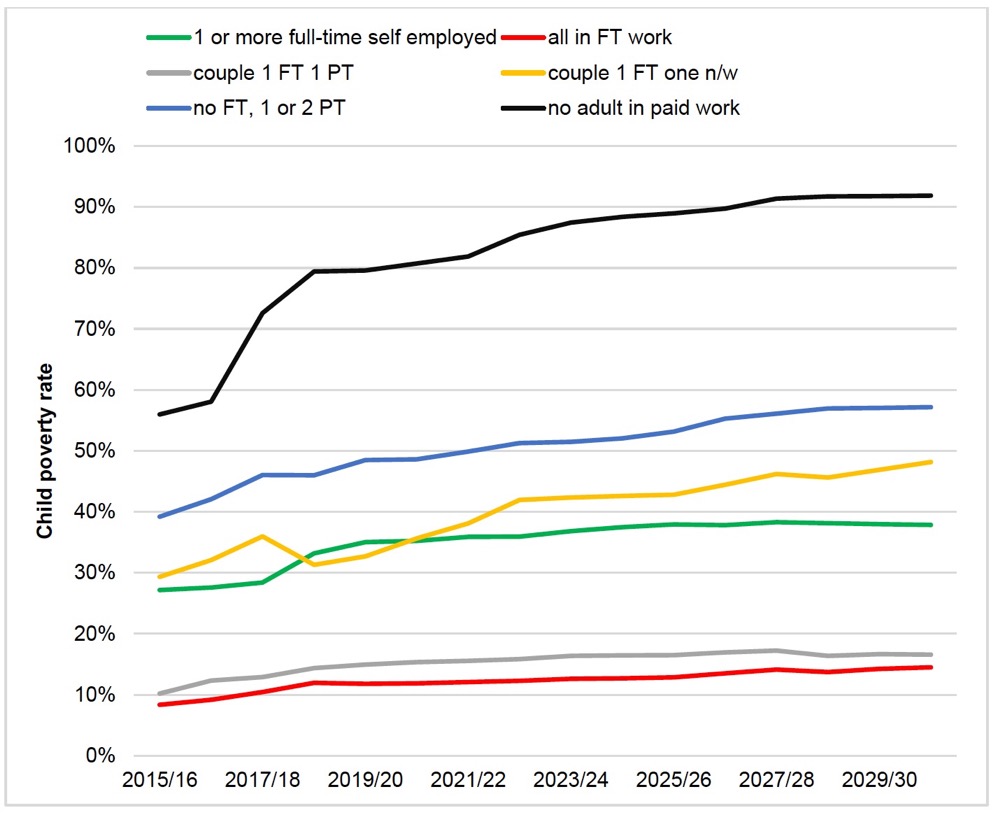
Source: calculations based on outputs from tax-transfer model using FRS pooled dataset 2012/13 to 2015/16
3.5 Robustness analysis
This section presents the results of our robustness analysis of the results in this report. We vary some of the key parameters in the simulations and show how these variations affect the headline poverty results. The results in this section refer to child poverty measure 1 (relative poverty); we also present results in Appendix 4 for child poverty measure 2 (absolute poverty).
Varying population growth assumptions
Figure 3.15 presents our headline poverty forecast (as shown in Figure 3.1 above) under the heading ‘central scenario’. The green dotted line ‘low pop growth’ shows the impact on the forecast poverty rate of using population forecasts from the Scottish Government which use lower projections for fertility, life expectancy and migration, whereas the red dotted ‘high pop’ growth line uses higher projections for fertility, life expectancy and migration. Meanwhile, the yellow dotted ‘zero net migration’ line uses a forecast where fertility and life expectancy are in line with the central scenario but net migration is set to zero.
The results show that higher population growth leads to an increase in the forecast poverty rate, with the gap between the central scenario and the high population scenario increasing in later forecast years. By 2030/31 forecast poverty is estimated to be around 3 percentage points higher in the high population scenario than in the central scenario. For the low population growth scenario, the effects go in the other direction, with forecast child poverty growth being lower. By 2030/31, poverty is forecast to be around 3 percentage points lower in the low population growth scenario than the central scenario. The impact of assuming zero net migration, with no other changes to the central scenario population forecast, is that child poverty is forecast to be slightly lower than in the low population growth scenario (around another 1 percentage point lower).
Figure 3.15. Impact of different population growth assumptions on child poverty measure 1
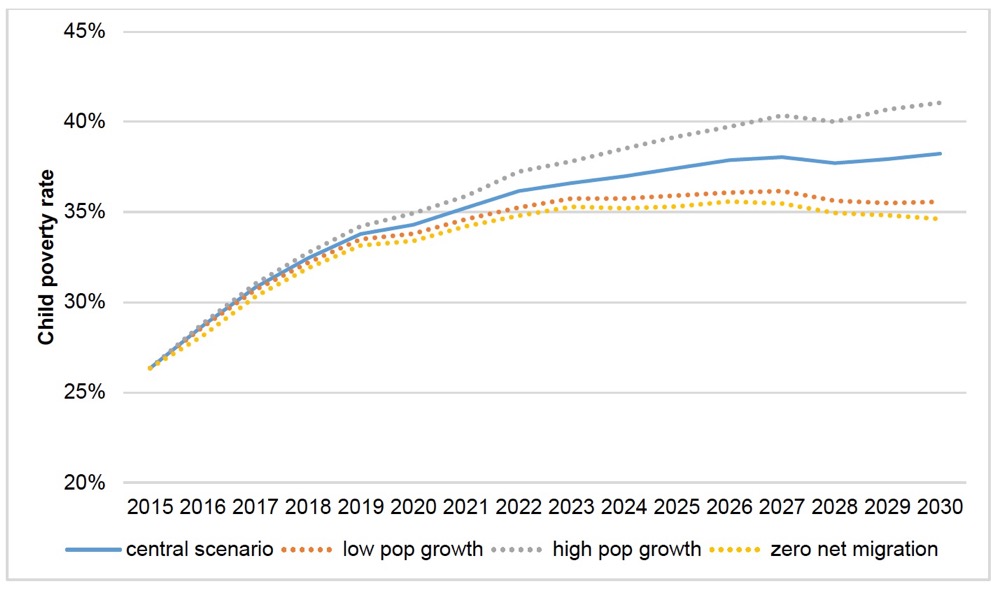
Source: calculations based on outputs from tax-transfer model using FRS pooled dataset 2012/13 to 2015/16
Varying employment growth assumptions
Figure 3.16 shows the impact of assuming that employment growth in the Scottish economy will be higher or lower than in the central forecast. The green dotted line labelled ‘high employment’ shows results for a scenario where employment is 10% higher than in the central scenario with all other simulation parameters unchanged, while the red dotted line labelled ‘low employment’ shows results for a scenario where employment is 10% lower than in the central scenario. The results show that varying the employment rate has only a minor impact on measured poverty rates; the effect is a maximum of about 0.5 percentage points in either direction. It should be noted that these forecasts assume that the composition of additional employment (in terms of the demographic characteristics of the additional people entering employment in the high employment scenario, or leaving employment in the low employment scenario) is similar to the overall profile of employment in the Scottish economy. Varying this assumption might lead to larger shifts in child poverty as a result of increased or decreased employment (for example, research by Reed and Portes, 2014, for the Social Mobility and Child Poverty Commission found that forecasts of the UK child poverty rate in 2020 were fairly sensitive to assumptions about increased employment for subgroups of the household population with relatively high child poverty rates, such as lone parents).
Figure 3.16. Impact of different employment growth assumptions on child poverty measure 1
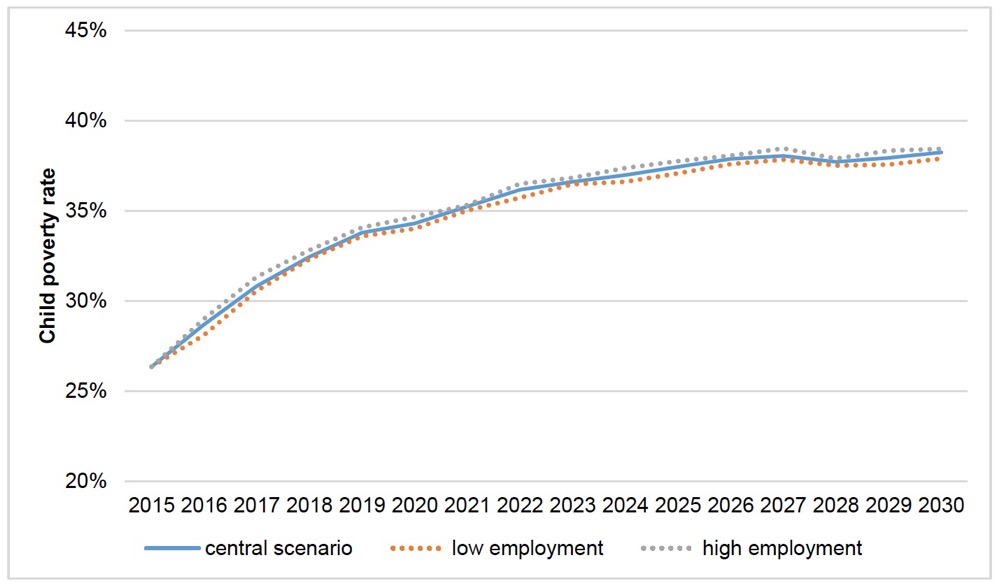
Source: calculations based on outputs from tax-transfer model using FRS pooled dataset 2012/13 to 2015/16
Varying wage growth assumptions
Figure 3.17 shows the impact of assuming higher or wages across the UK economy (including Scotland) compared to the central scenario. The green dotted line labelled ‘high wage growth’ shows results for a scenario where wage growth is 0.5 percentage points per year above the central forecast, while the red dotted line ‘low wage growth’ shows results for a scenario where wage growth is 0.5 percentage points per year below the central forecast. The yellow dotted line ‘zero wage growth’ shows a scenario where there is no average wage growth (in real terms) for the rest of the forecast period after 2017-18.
Figure 3.17 shows that assuming lower wage growth leads to a decrease in forecast child poverty while assuming higher wage growth leads to an increase. This is a well-known finding from previous analysis of child poverty statistics; given that social security benefits and tax credits normally increase in line with price inflation (although at the moment most working-age social security uprating is frozen until 2020-21), higher real wage growth tends to increase the relative poverty line relative to the value of means-tested benefits and tax credits, pushing more households with children into poverty. Figure 3.17 shows that in the ‘high wage growth’ scenario, measured child poverty is just under 1 percentage point higher by 2030/31 than in the central scenario, whereas in the ‘low wage growth’ scenario measured child poverty is around 1 percentage point lower than in the central scenario. In the ‘zero real wage growth’ scenario, measured child poverty by 2030/31 is around 2 percentage points lower than the central scenario.
Figure 3.17. Impact of different wage growth assumptions on child poverty measure 1
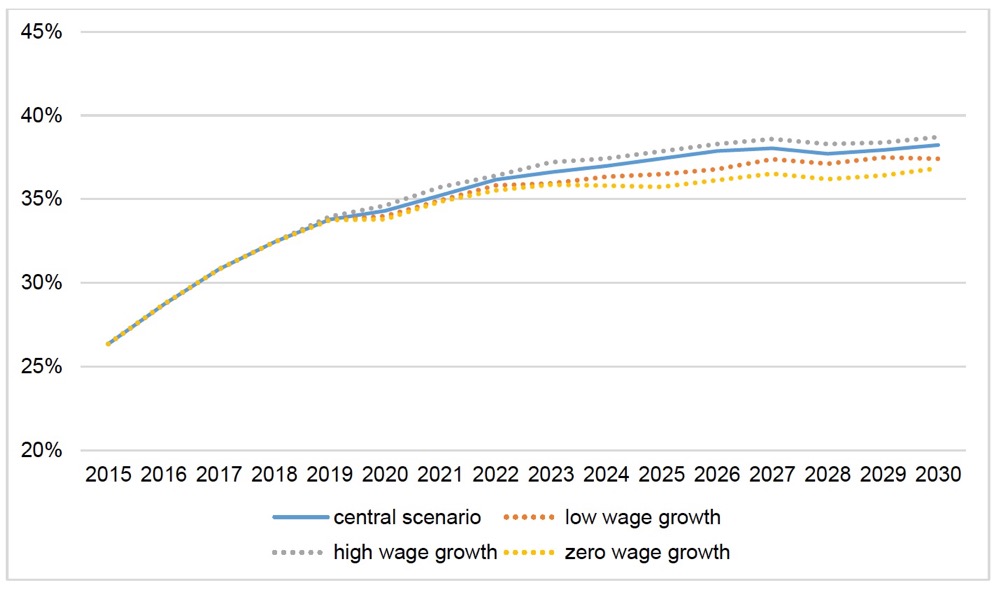
Source: calculations based on outputs from tax-transfer model using FRS pooled dataset 2012/13 to 2015/16
Other robustness checks
Figure 3.18 shows the impact of a range of other variant scenarios that we ran as robustness checks on the main results, which did not fit into any of the categories above. To summarise the main findings:
- When no reweighting is used on the FRS sample from 2016/17 onwards (i.e. stripping out all the effects of forecast demographic and employment changes) there is very little change to the poverty rate until the final five years of the forecast, where forecast poverty is slightly higher than the central scenario (about 1 percentage point by 2030/31.
- Assuming full take-up of means-tested benefits, tax credits and Universal Credit leads to a slightly higher forecast increase in measured child poverty between 2015/16 and 2023/24 but then a slower rate of increase in subsequent years.
- Assuming a slower roll-out of Universal Credit (over four years between 2017/18 and 2020/21) makes almost no difference to forecast poverty rates.
- Using the OBR macro forecast for Scotland as well as the rest of the UK makes almost no difference to forecast poverty rates.
Figure 3.18. Impact of other robustness checks on child poverty measure 1
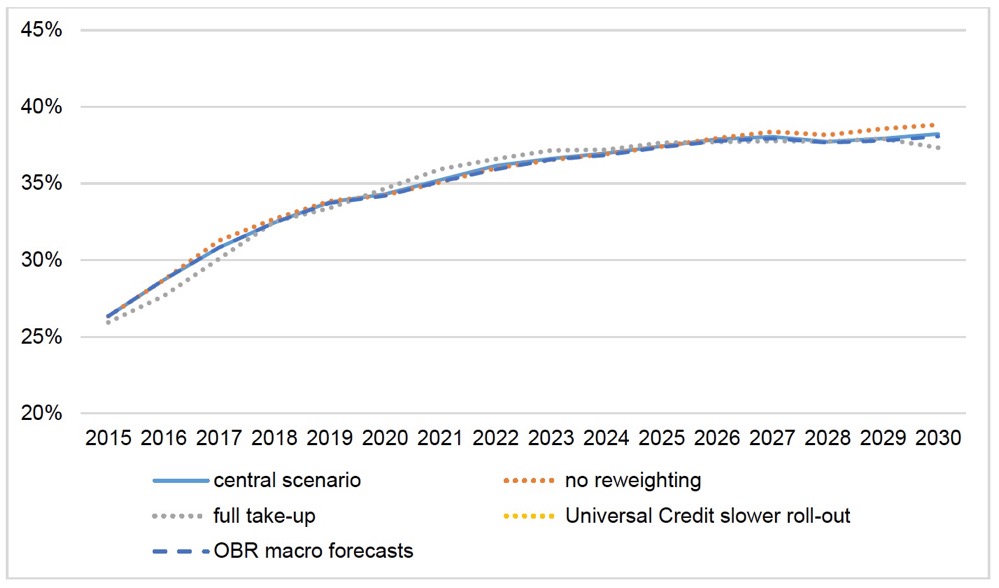
Source: calculations based on outputs from tax-transfer model using FRS pooled dataset 2012/13 to 2015/16
Comparison with IFS findings
This section presents a comparison of our headline estimates of the child poverty rate with recent simulation results published by the Institute for Fiscal Studies (Hood and Waters 2017). The IFS study forecast poverty rates for the whole UK but also provided a regional breakdown. The IFS reports poverty rates averaged over the years 2019-21. We have compared these with our averaged forecasts from the same time period for Measure 1 (relative poverty) and Measure 2 (absolute poverty) [24] . The results show that our estimated poverty rates for 2019-21 are somewhat higher than the IFS estimates; around 4.5 percentage points higher for measure 1 and over 6 percentage points for measure 2. There are several possible reasons for the discrepancy between the two sets of forecasts:
- The roll-out of Universal Credit is generally assumed to increase take-up as a share of total possible expenditure on social security relative to the ‘legacy’ benefits and tax credits which it replaces, because it is a single payment which replaces a range of benefits and tax credits and the FRS data shows that many households who are entitled to (for example) tax credits and Housing Benefit under the legacy system claim only one or the other, whereas by claiming Universal Credit they become eligible for a single payment which replaces both. However, we make a downward adjustment to Universal Credit take-up of around five percentage points (as a proportion of eligible claimants) to reflect recent data showing that the rate of sanctioning for UC claimants is higher than for the benefits which preceded it (Webster, 2017). This results in an increase in the forecast poverty rate for 2018/19 and subsequent years in our analysis.
- There may be other differences in the algorithms which the IFS’s TAXBEN model uses to model aspects of the tax and social security system and the algorithms used in our TTM model. In correspondence with the IFS authors we were unable to identify any really major discrepancies between the two models, although we lacked the time or funding for a detailed comparison at the level of underlying programming code.
- Because the IFS study only forecast poverty forward to 2020/21 whereas our study produces forecasts to 2030/31, IFS were able to use a more complex set of weights than we have used, including regional household projections, the number of people aged 65 or over with private pensions, and employment rates by 10 year age brackets, for men and women. However, re-estimating our child poverty measures using a more complex set of “ IFS-style” weights up to 2020/21 produced very little change in our headline forecasts.
- The particularly large discrepancy for the absolute poverty measure may be partially explained by the fact that we used the November 2017 forecasts from the Office for Budget Responsibility for the macroeconomic variables (for countries other than Scotland) whereas IFS used the March 2017 OBR forecasts (because the November 2017 forecasts had not come out at the time their research was completed). In the November 2017 OBR forecasts (and the December 2017 Scottish Fiscal Commission forecasts which we use for Scotland) projected growth in real wages is significantly lower than in the March 2017 OBR forecasts. This means that absolute poverty for households with at least one person in paid employment is higher using the November and December 2017 forecasts than the March 2017 forecast.
Table 3.1. Comparison of our 2019-21 estimates with recent IFS estimates
| Child poverty rate (%) |
||
|---|---|---|
| Study |
Measure 1 (relative) |
Measure 2 (absolute) |
| Hood and Waters (2017) |
29.0 |
25.0 |
| Our results |
33.5 |
31.3 |
| Discrepancy (ppts) |
4.5 |
6.3 |
Summary of results of robustness analysis
Our analysis of the robustness of the headline results in this report suggests that varying most of the parameters for the analysis – wages, overall employment rates, the speed of roll-out of Universal Credit and the use of OBR or SFC forecast variables – makes only a minor difference to the results. The only parameter tested here which does make a more substantial difference to the forecast poverty measures is the population projections. As discussed in the Section 1.x, this may reflect the heightened uncertainty over key population parameters in the wake of the EU referendum vote in 2016. However, even in this case, our key finding of a substantial increase in relative and absolute child poverty remains robust to different assumptions on population growth.
As documented in the DWP’s Households Below Average Income and the Scottish Government’s Poverty and Inequality in Scotland publications, the equivalised household disposable income distribution is particularly dense around the relative and absolute poverty lines, and minor differences in methodology can make a substantial difference to forecast poverty rates. This is shown in the comparison between our results and the IFS results. A more in-depth analysis of the reasons why we forecast a bigger increase in child poverty in Scotland than the IFS would be a useful subject for future research.
Contact
There is a problem
Thanks for your feedback